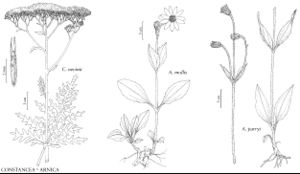Difference between revisions of "Arnica parryi"
Amer. Naturalist 8: 213. 1874.
FNA>Volume Importer |
FNA>Volume Importer |
||
| Line 8: | Line 8: | ||
}} | }} | ||
|common_names=Parry’s arnica;nodding arnica | |common_names=Parry’s arnica;nodding arnica | ||
| − | |basionyms={{Treatment/ID/ | + | |basionyms={{Treatment/ID/Basionym |
|name=Arnica angustifolia subsp. eradiata | |name=Arnica angustifolia subsp. eradiata | ||
|authority=A. Gray | |authority=A. Gray | ||
| + | |publication_title=Proc. Acad. Nat. Sci. Philadelphia | ||
| + | |publication_place=15: 68. 1864 | ||
}} | }} | ||
|synonyms={{Treatment/ID/Synonym | |synonyms={{Treatment/ID/Synonym | ||
| Line 56: | Line 58: | ||
|publication year=1874 | |publication year=1874 | ||
|special status= | |special status= | ||
| − | |source xml=https://jpend@bitbucket.org/aafc-mbb/fna-data-curation.git/src/ | + | |source xml=https://jpend@bitbucket.org/aafc-mbb/fna-data-curation.git/src/f6b125a955440c0872999024f038d74684f65921/coarse_grained_fna_xml/V19-20-21/V21_933.xml |
|tribe=Asteraceae tribe Heliantheae | |tribe=Asteraceae tribe Heliantheae | ||
|subtribe=Asteraceae (tribe Heliantheae) subtribe Chaenactidinae | |subtribe=Asteraceae (tribe Heliantheae) subtribe Chaenactidinae | ||
Revision as of 18:50, 24 September 2019
Plants 15–50(–60) cm. Stems simple or branched among heads. Leaves (2–)3–4 pairs, basal and cauline (basal usually withered by flowering, petiolate or subsessile, blades ovate or nearly round to oblong-ovate, much smaller than cauline; sterile rosettes often present, proximal cauline often crowded toward stems bases); petiolate; blades broadly to narrowly lanceolate, oblong-ovate, ovate-lanceolate, or round, 4–22 × 1–6 cm, (bases obtuse or cuneate to truncate) margins usually entire, sometimes sparsely denticulate, faces scantily to moderately pilose (hairs white), adaxial sparsely stipitate-glandular (distal cauline leaves sessile, extremely reduced, nearly linear to narrowly elliptic-lanceolate). Heads (1–)3–9(–14; often nodding in bud). Involucres turbinate to narrowly campanulate. Phyllaries 8–20, linear to narrowly lanceolate. Ray florets usually 0 (sometimes peripheral florets pistillate; corollas yellow, laminae rudimentary). Disc florets 20–50; corollas yellow (1 or more lobes sometimes expanded, giving appearance of laminae); anthers yellow. Cypselae brown to black, 4–7 mm, glabrous or sparsely stipitate-glandular to densely hirsute; pappi usually stramineous, rarely tawny, bristles barbellate to ± subplumose. 2n = 38, 57, 76.
Phenology: Flowering May–Sep.
Habitat: Open conifer forests to alpine meadows
Elevation: 500–3800 m
Distribution

Alta., B.C., Yukon, Calif., Colo., Idaho, Mont., Nev., Oreg., Utah, Wash., Wyo.
Discussion
Selected References
None.
